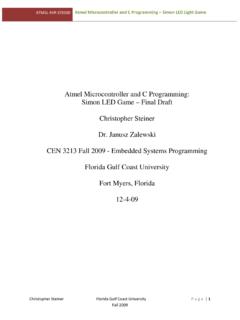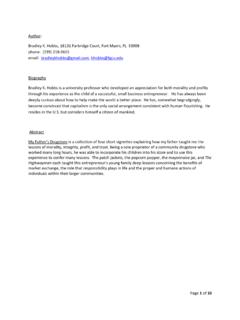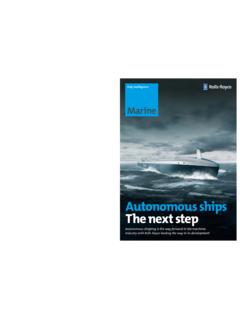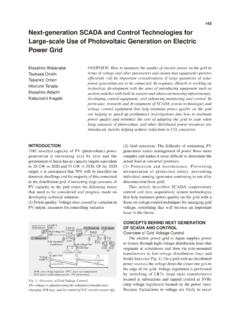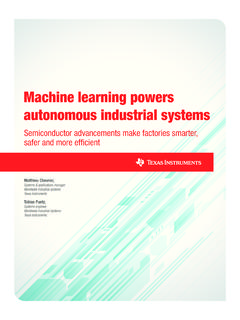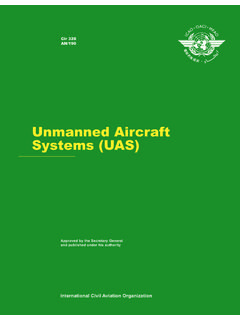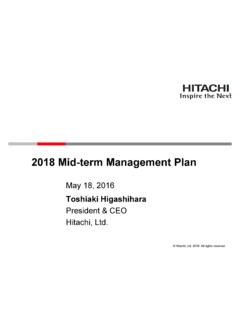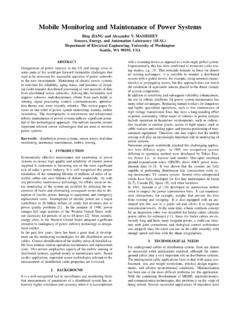Transcription of REVIEWPAPER 157 State-of-the …
1 REVIEW PAPER 157 State-of-the -art in integrated vehicle healthmanagementO Benedettini1,2 ,T S Baines2, HW Lightfoot2,andR M Greenough21 Department of Mechanical and management Engineering, Politecnico di Bari, Bari, Italy2 Department of Manufacturing, School of Applied Sciences, Cranfield University, Cranfield, UKThe manuscript was received on 21 August 2008 and was accepted after revision for publication on 11 November : :Integrated vehicle health management (IVHM) is a collection of data relevant to thepresent and future performance of a vehicle system and its transformation into informationcan be used to support operational decisions. This design and operation concept embracesan integration of sensors, communication technologies, and artificial intelligence to providevehicle-wide abilities to diagnose problems and recommend solutions.
2 This article aims to reportthe State-of-the -art of IVHM research by presenting a systematic review of the literature. Theliterature from different sources is collated and analysed, and the major emerging themes arepresented. On this basis, the article describes the IVHM concept and its evolution, discussesconfigurations and existing applications along with main drivers, potential benefits and barriersto adoption, summarizes design guidelines and available methods, and identifies future :integrated vehicle health management , review, health management , condition-basedmaintenance1 INTRODUCTIONThe concept of integrated vehicle health manage-ment (IVHM) is an evolution of diagnostic and prog-nostic systems [1,2].
3 The goal is to implement anadvanced prognostics and health management (PHM)strategy that enables continuous monitoring and real-time assessment of vehicle functional health, pre-dicts remaining useful life of fault or near failurecomponents, and uses this information to improveoperational decisions. Here, maintenance operationsbenefit from reduced occurrences of unexpectedfaults as the health management system will pro-vide early identification of failure precursors while,simultaneously, condition-based maintenance (CBM)is enabled, which can enhance availability, missionreliability, system life, and affordability ( refer-ences [1] and [3]to[5]).
4 Similarly, command andcontrol functions rely on an improved awareness of Corresponding author: Department of Mechanical and Man-agement Engineering, Politecnico di Bari, viale Japigia 182,Bari 70126, Italy. email: condition and vehicle situational capabilities,and so also safety, utilization, vehicle turnaround,and the chance of mission success can increase[2,6,7].For some authors, the scope of an IVHM systemalso includes logistics management . The underpin-ning expectation is that the availability of continuouslyupdated and detailed vehicle health information canbe used to automatically trigger logistics actions. Anexample of an extended IVHM system that comprisesboth the vehicle and its support infrastructure isthe US Department of Defense (DoD) s Joint StrikeFighter ( JSF) programme [4,8].
5 The JSF programme isleading the development of next generation strikeweapon systems for the US Navy, Air Force, andMarine Corps. Here, the vehicle is being designedwith a fully functional PHM system that performsfault detection, isolation, and reconfiguration acrossnumerous components and subsystems ( airframestructures, engine, electronics, hydraulics, fuel, andelectric power systems). The PHM system also relaysaircraft status data to a distributed information systemthat processes PHM calculations together with otherinformation about the vehicle and the logistic cycleand, if maintenance is required, informs the supplyJAERO446 IMechE 2009 Proc.
6 IMechE Vol. 223 Part G: J. Aerospace Engineering158O Benedettini,T S Baines, HW Lightfoot, and R M Greenoughchain infrastructure of the need for parts, tools, testequipment, manpower, and support is a potentially valuable strategy for themanufacture and management of vehicle , there are deep financial uncertainties inboth military and commercial vehicle markets andtherefore intense pressure to reduce costs [6]. Hence,much attention is being given to the operationaland support activities that contribute a very largeproportion of the lifecycle total ownership costs ofmodern vehicles [9,10]. Commercial aerospace expe-rience has shown that nearly 95 per cent of aircraftlifecycle costs are attributable to maintenance activi-ties [11].
7 Similarly, the US government records havehistorically shown that the cost of operating and sup-porting a vehicle may exceed the initial purchaseprice as much as ten times [12]. In this climate, itwould appear that the new generations of vehicleplatforms will undergo substantial changes and willintegrate distinctive technological progress to improvein-service operations. The current vision is that newand legacy vehicles should be provided with advancedtechnology-based intelligence functions that shouldenable more informed decisions on the design, usage,maintenance, and support [13,14]. This is entirelyconsistent with the adoption of an IVHM philosophythat uses merging and strong coupling of interdisci-plinary trends from the engineering sciences, com-puter sciences, and communication technologies toachieve the cheapest possible and most effective concept of IVHM has been discussed for sometime (see Reichardet al.)
8 [7], Birdet al.[11], Barothet al.[13], Fox and Glass [15]), yet the applications appearlimited. Although many potential benefits are evident,obstacles have been reported to arise from the need todevelop the IVHM technologies and then to accuratelyevaluate the challenges and risks of IVHM adoption( reference [16]). However, a concerted and coor-dinated research programme could address many ofthese obstacles and provide a platform of tools andprinciples that enable a wide scale adoption of IVHMby manufacturers and owners of vehicle systems. Suchresearch requires a thorough and precise understand-ing of the existing knowledge and so the purposeof this article is to describe the State-of-the -art study in this article has taken the form of a sys-tematic literature review.
9 The methodology consistedof targeting relevant publication databases, search-ing these using a wide range of keywords associatedwith IVHM, and then reviewing each article identi-fied. The outcome of these reviews was the extractionof a set of key findings. Hence, the article is struc-tured as follows. First, the search strategy is describedand applied to the identification of the relevant pub-lications. Then, the key themes emerging from thesepublications are analysed and the related findingsare presented. Finally, the results of the analysis aresummarized and conclusions are RESEARCH Aim, scope, and research questionsThe aim of the research presented in this article hasbeen to identify, interpret, and summarize the liter-ature currently available on IVHM.
10 The scope of thisstudy has been to put together the publications thatare relevant to IVHM within a wide range of indus-trial sectors. The word vehicle in the IVHM acronymhas been therefore related to any type of vehiclesystems, ranging from spacecrafts to aircrafts, cars,trucks, ships, trains, helicopters, submarines, tanks,and so on. However, only articles that explicitly relateto the context of vehicle systems have been included,whereas those that refer to PHM of technical assetsin general are tailored to stationary applications ( applications) and have been avoided. Sim-ilarly, articles discussing individual aspects of IVHM( sensor strategies, data processing techniques, andcommunication technologies) or IVHM functionali-ties in isolation ( subsystem-level health manage-ment and health monitoring applications) have beenexcluded unless direct relevance to the topic of IVHM could be established.
